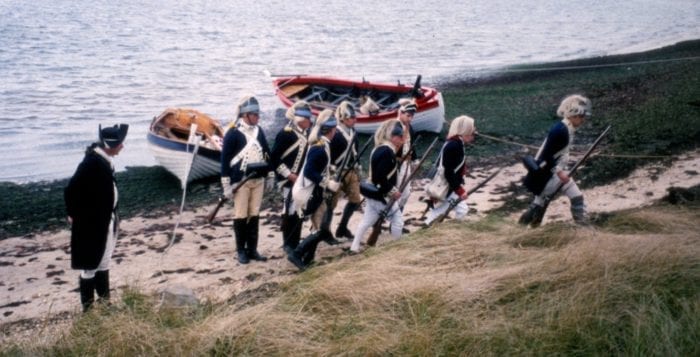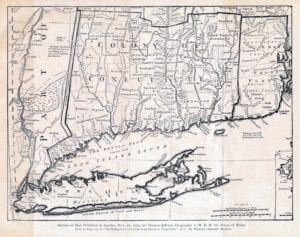Culper spy Caleb Brewster fought on the Long Island Sound

By Beverly C. Tyler
On Thursday morning, Aug. 17, 1780, fog covered the Connecticut coast and obscured any view of three whaleboats as they slid through the marsh grass and into the shallow water at the northeast corner of Black Rock Harbor. Six of the men in each boat quietly slid their oars into the water and together with each sweep, without a word spoken, the men’s oars began a rhythmic parallel stroke that moved the crafts quickly through the harbor and into Long Island Sound.
In the traditional whaleboat, to get leverage for speed, five oarsmen sat on opposite sides of the boat from their oarlocks, and their long oars propelled the whaleboat at up to 5 or 6 miles an hour. However, on these whaleboats, with as many as six additional soldiers, their arms and equipment, it was not practical to have long oars working across the boat so, especially for long distances, sailing rather than rowing, was the main means of propulsion.

The three identical whaleboats were each 30 feet long, lapstrake-built and pointed at both ends. They were light, being constructed of a strong oak frame and planked with half-inch cedar, to form a relatively narrow and sleek vessel that was exceptionally seaworthy and highly maneuverable. These open boats, greyhounds of the Sound, were also easy to enter and exit, making them exceptional platforms from which to surprise and successfully attack slower and less maneuverable craft.
As the whaleboats moved away from the shore and headed south for Long Island, ripples and spray off the top of the swells ahead indicated a moderate northwest wind, and the men shipped their oars and raised the mast and sail on each whaleboat. They then sat lower in the boat on the starboard or windward side to add stability. Every soldier and sailor was usually equipped with a musket and/or a pistol, a short sword or saber and often a belt ax, as well as a powder horn, cartridge box and other equipment.
The man in charge of the three whaleboats, Caleb Brewster, sat in the bow of the lead whaleboat peering through his telescope to see what other activity was around him on Long Island Sound. Brewster was a seaman and a courier spy for Gen. George Washington, but he was also an artillery captain in the Continental Army, and his three crews of sailors were partly recruited from the ranks of the men he commanded. Brewster’s crews also contained a number of Long Island friends who were trusted associates such as Lt. George Smith of Smithtown and Capt. Abraham Cooper Woodhull, formerly of Old Mans on Long Island, now a resident of Fairfield, Connecticut, and captain of one of Brewster’s whaleboats.
In addition to the 12 men, each whaleboat had a small swivel gun on the bow powerful enough to put a hole in an enemy boat below the waterline or disable a mast with a lucky shot when close in. These three whaleboats were a potent fighting force, able to attack and capture the sloops, schooners and small British and Tory brigs that patrolled the Sound or the plunderers, both Whigs and Tories, who regularly attacked residents on Long Island and along the Connecticut shoreline.
On this day, Brewster was headed to Long Island to pick up intelligence from his friend and fellow Culper spy Abraham Woodhull. When he arrived, he found that Woodhull was in New York City and would be relaying his messages by way of Austin Roe by 2 p.m. on the following day. Brewster had to wait.
On Friday morning Brewster and his whaleboat crews were attacked by plunderers Glover and Hoyght —possibly Ezekiel Glover and Simon Hoyt, refugees from Long Island — and their crews. In Brewster’s report to Benjamin Tallmadge, Washington’s intelligence chief, he wrote, ”I came from Long Island this afternoon but have got no dispatches. Culper has been down to New York. I waited until this morning and he was to send them by two o’clock but before he sent them I was attacked by Glover and Hoyght and left one man taken and one wounded. We killed one on the spot … Austin told me that Sir Henry Clinton went down to the east end of the Island on the sixteenth. Don’t fail to let me have two crews if you can of Continental soldiers.”
In another letter to Tallmadge written on Monday, Aug. 21, Brewster reported, “I this morning came from the island & got three boats last Saturday night and went over in search of Glover and Hoyght but could hear nothing of them. They never stayed to bury their dead man, they carried another away with them mortally wounded. Setauket is full of troops. It is thought they are going eastward. Austin came to me yesterday and told me I had best not come on to the middle of next week as the troops is so thick in town and marching eastward.”
Brewster continued to patrol Long Island Sound and bring intelligence from Long Island to Fairfield, Connecticut, until Dec. 7, 1782, when he and several of his whaleboats chased and attacked three enemy boats about mid-Sound. They captured two boats but the third escaped. Brewster was wounded when a musket ball went through his chest. He reported that he continued to fight until the enemy was captured and then collapsed. Every man on the enemy’s boats was either killed or wounded as were the men on Brewster’s boats. Brewster spent many months recovering in the hospital in Black Rock.
Beverly C. Tyler is Three Village Historical Society historian and author of books available from the society at 93 North Country Road, Setauket. For more information, call 631-751-3730 or visit www.tvhs.org.






